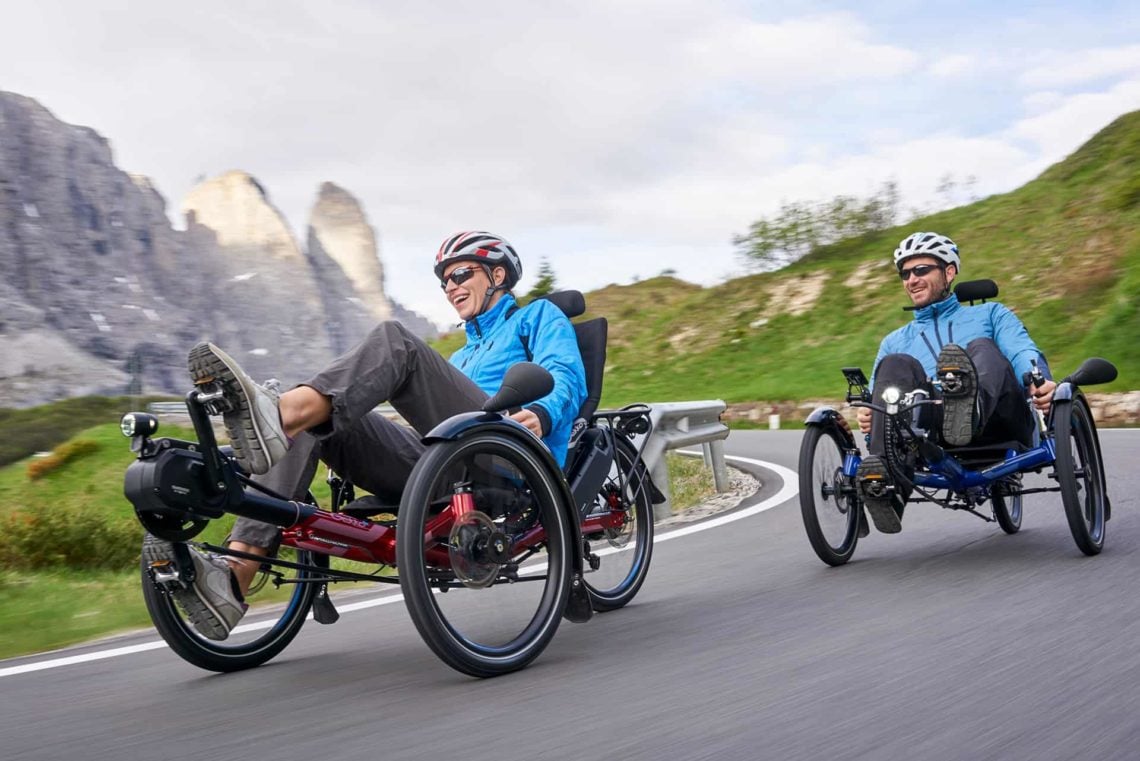Wheel Size: 20 Inch vs. 26 Inch
Pros & Cons for Recumbents
20 inch or 26 inch? This is a common topic with recumbent bikes or trikes – especially with a tadpole design. In detail, it usually comes down to the size of the rear wheel. This provides propulsion for our two-wheelers and three-wheel recumbents.
About the best wheel size for recumbents people have different opinions. A matter of personal belief? Not really! Both small 20″ and large 26″ wheels have their pros and cons. These can actually be defined quite well in general terms. In the end, it depends – as with the recumbent bike or trike itself – on the intended use. And the requirements associated with it…
20 inch
Compact and Robust
The compact 20-inch rear wheel is something of a classic for recumbent trikes – and not just for us. The first tricycle from HP Velotechnik, the “original Scorpion” (see photo), a tadpole trike, rolled out of the factory on three 20-inch wheels.
We currently offer trikes with a 20″ rear wheel in the Scorpion series and Gekko series. Our Delta tx sits and rides on two 20-inch rear wheels. The Grasshopper fx folding trekking recumbent also takes advantage of this wheel size.
Certainly one of the obvious benefitsare the more compact dimensions. The bike can be designed to be shorter overall. And for the same reason, our foldable recumbents can generally be folded even smaller than their 26-inch counterparts. The 20-inch rear wheel also gives a tighter turning circle and more room for luggage.
In comparison, the 20-inch wheel itself is more stable and more resistant to bumps and knocks, not just vertically. The relatively short spokes on the smaller wheel are at a less steep angle and can therefore absorb greater forces.
Nimble and Agile
The lower leverage effect of a 20-inch wheel results in less torsional stress on the rear triangle during fast cornering. This is relevant to three-wheelers because it is not possible to lean yourself into a bend together with the trike. Bicycles lean in the direction of these lateral forces and absorb them “downwards”.
In terms of riding dynamics, the 20-inch wheel also scores because it is lighter and less sluggish than a large wheel: it rotates more agile, i.e. in principle it can be accelerated with less energy input.
This is particularly advantageous in urban stop-and-go traffic, where the compact bike can make full use of its maneuverability moreover. But the agility is also useful when going uphill. Not to forget that smaller gear ratios are easier to achieve. The weight advantage also contributes to the overall weight.
Comfort Is Relative
Considering the frame geometry, the rear wheel can be mounted closer to the seat. As a result, it’s located closer to the center of gravity of the entire system. Or vice versa: the bike as a whole has a relatively more rearward center of gravity. This benefits traction, while providing a balanced weight distribution in the overall system with the rider.
Any compromises in comfort due to the small wheels are compensated for by a good chassis with suspension . Again, the 20-inch wheel benefits from its lower weight here, as it reacts more quickly to bumps thanks to its lower unsprung mass. Without a suspension, wide, high volume tires can at least soak up the biggest bumps on rough roads.
When traveling with a recumbent, globetrotters appreciate not only the robustness and increased luggage capacity, but also the reduced need for spare parts: Tubes and tires only need to be carried in one size. This is convenient when traveling, but also easier for your own workshop at home.
26 inch
Striking and Smooth Running
26-inch wheels have found a large following among trike fans, especially in recent years. Often this is simply for stylish reasons. But why not? After all, large rear wheels not only look great, they also offer a number of advantages.
The two-wheeled classics from HP Velotechnik, the Streetmachine Gte and Speedmachine, were designed with 26″ rear wheels from the very outset. But even our fastest e-trike, the Scorpion fs 26 S-Pedelec, consciously comes with the large drive unit in the rear.
Speed? A Safe Bet!
With 26-inch wheels, the focus is clearly on dynamic handling. This includes better rollover characteristics over obstacles on one hand. While you don’t have to go off-road to get this: even on fairly good roads, the larger wheel offers noticeably more comfort. It absorbs bumps and jolts that you would feel on a 20-inch wheel. Of course pleasant, but also a safety plus!
The design of the frame geometry also contributes to safety. The relatively long wheelbase ensures a smooth ride and directional stability even at high speeds. In addition, the center of gravity of the entire system is closer to the front axle. This reduces the tendency of tadpole trikes to tip over when cornering at speed.
The larger and more outward flywheel mass of the 26-inch wheel comes into its own when gliding through the countryside. Once up to speed, the bike feels like it just wants to keep going – not only downhill, but also on the flat. A smaller wheel would have to turn much faster to achieve the same speed.
A Question of Drive
With an electric rear wheel drive such as the Neodrives system, the last point is important: if the terrain is mainly very steep, the 20-inch drive has an advantage on climbs because it turns faster and thus ensures that the motor works more efficiently at lower speeds.
More space for the rear derailleur: the chain tensioner, which is not only necessary for derailleur systems, is naturally located higher above the ground on a 26″ wheel. This means that the drivetrain is less exposed to swirling dust and dirt, even with longer derailleur cages.
With good drivetrain maintenance, however, this is not really a problem and is more or less reduced to visual appearance. The same goes for the relatively smaller chainrings at the front of the bottom bracket on 26″ bikes: Here it is easier to match the chain length and gearing so that all gear combinations are possible (e.g. “large/large”). In the end, however, certain combinations should be avoided anyway and so, despite all the technical advantages, we inevitably end up with the question of personal taste.
Direct comparison
20 Inch vs. 26 Inch - In a Nutshell
20-inch wheel
- More compact dimensions. Bike or trike shorter overall. Also more compact when folded.
- Smaller turning circle.
- More storage space for luggage
- Center of gravity closer to the contact patch, wheel closer to the seat + traction of the rear wheel.
- Relatively lighter wheel.
- Lower inertia. Wheel can be accelerated faster or with less energy expenditure. Especially advantageous uphill and in urban traffic (stop and go).
- More stable and resistant to bumps and impacts from different directions. Also, less leverage and therefore less torsional influence when cornering fast (especially on trikes).
- Spare parts supply – only one size of tubes and tires for the whole bike.
26-inch wheel
- Better rollover characteristics over obstacles – for safety and comfort.
- Better directional stability at high speeds.
- Center of gravity closer to front axle – reduces tendency to tip over.
- Higher inertia – maintains speed well with high flywheel mass, but must be accelerated first. In general, lighter wheels always have an advantage.
- Wheel does not have to rotate as fast at high speeds .
- Smaller chainrings for same gear ratio and cassette.
- Rear derailleur / chain tensioner is higher above the ground. This means less dirt on the derailleur pulleys.
Found the Best Wheel Size? Here Is More to Choose From!
All models and options: Our online configurator lets you choose from our versatile modular system to build the bike of your dreams.










